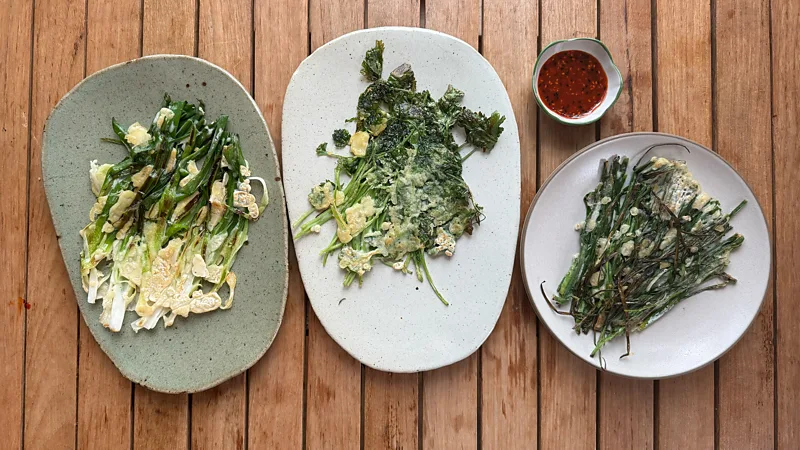A Korean feast that honours Buddha's birth
Every year, millions of people celebrate the founder of Buddhism's birth by enjoying free meals at temples.

After the cherry blossom petals fall, strings of paper lanterns begin to appear across South Korea, dangling from trees and lacing the streets to announce the arrival of Buddha's birthday. Temple visitors are greeted with a kaleidoscope of colour on the day of the celebration – which has been recognised as a national holiday for nearly 50 years in South Korea, where 16% of the population is Buddhist – and can often enjoy a free bowl of sachal bibimbap (temple bibimbap) packed with seasonal vegetables representing ohbangsaek, the five colours of the Universe (after braving the long lines, that is).
A celebration of springtime, Buddha's birthday will take place on 15 May this year, with millions of people in Korea expected to come together to commemorate the birth of Siddhartha Gautama, the wandering ascetic and religious teacher who founded Buddhism in the 6th or 5th Centuries BCE.
From thousands of miles away, chef Ji Hye Kim is creating her own iteration of temple bibimbap in Michigan.
Born in Seoul, Kim remembers sitting around the table pinching the edges of mandu (dumplings) and slurping down a warm bowl of red bean porridge to mark Dongji, the winter solstice. She held onto those early memories as she immigrated to the United States as a young teenager, and later when she opened her Ann Arbor restaurant, Miss Kim, in 2016.
"But I felt a void in what I was doing," Kim said. She could glide through cookbooks written in Korean, handpicking recipes to test. But the ingredients in front of her seemed to stare back in silence as she found her adult self unable to piece together the story of the dishes she grew up eating.
Burying herself in historical Korean cookbooks, Kim fell down a rabbit hole that led her to discover Buddhist nuns and priests who found a way to prepare a version of kimchi that omitted saewoo-jut (the salted, fermented shrimp prized for its savoury umami) and instead leveraged simplicity to deepen its flavours.
"It's difficult to separate fish sauce or saewoo-jutout of kimchi," said Kim. But after seeing that it was possible, Kim began to see how "food evolves over time, and [how] it evolves with the people who cook it and [with] what's available" – a moment she described as "liberation".
"Kimchi didn't look like Napa cabbage kimchi today," Kim said. "It was like a salted vegetable, and the chilli flakes also came in later." There was also dongchimi, a milder white radish kimchi, as well as fresh cabbage geotjeori (a kimchi variant eaten fresh) that didn't need to be fermented. The list of ingredients Kim used to see on the pages of her cookbooks came to life.amy)
For more than 1,700 years, Buddhist temple food in Korea has used local, seasonal ingredients to help Buddhist priests "sustain their bodies in their pursuit of enlightenment", said professor Hyaeweol Choi, who teaches Korean gender history at the University of Iowa. To support a monastic lifestyle, the food is gentle and easy to digest, eschewing five pungent ingredients – onions, garlic, chives, green onions and leeks – that are said to stimulate the body and disrupt spiritual meditation. Meals served at temples on Buddha's birthday adhere to these practices and are strictly vegetarian.
Buddhist monasteries were established deep in the mountainous regions of Korea's southern provinces and survived centuries of oppressive Confucianist policies during the Joseon Dynasty (1392-1910).
Barred from entering the capital, Buddhist priests carried out their daily lives in the mountains, where an abundance of wild vegetables grew. Having to withstand long winters, they fermented soybean paste with salt to create jang that helped soften the bitterness of wild namul (greens) and also extended its shelf life.
Buddhist nun Seonjae Sunim describes food as medicine, with those preparing the food taking on the role of a yaksa, or pharmacist, armed with a deep understanding of each ingredient's healing properties.
During a temple food cooking class at Bongnyeong temple, about an hour south of Seoul, Sunim said that the cooking begins when you wash the namul. She explained that a slight difference in water temperature can alter the texture of the leaves, which have to be carefully untangled one by one. You must also be gentle when blanching vegetables, holding them upright so the solid stems go in first, and remembering not to squeeze out too much water to ensure that the perilla oil (made by cold-pressing the seeds of the perilla plant) can absorb well.
Sunim emphasised the importance of mindfulness when eating. "When we consume foods with bold flavours, whether spicy or heavy with salt, that can influence how much anger we manifest that day. The food that enters our body engages with our hearts and minds. It shapes the spirits we embody," she said.
Seasonality, paired with this mindfulness of the coexistence of all living things, is the essence of Buddhist temple food, and Kim said she is fascinated by the jeolgi system in particular. In Korea, there are four distinct seasons that are further divided into 24 jeolgi, or solar terms, according to the lunar calendar. Korean farmers adopted the concept, creating a timetable that could predict seasonal harbingers.
There is a new jeolgi roughly every two weeks. In 2024, Buddha's birthday falls between ipha and soman (the seventh and eighth solar term). Ipha marks the beginning of summer, when grains of barley begin to ripen into a golden yellow, just before soman, the busiest time of the year for farmers rushing to transplant rice seedlings.
Personally, Kim said her favourite "Michigan jeolgi" falls between the end of August and early September, when the Kerrytown farmer's market a block from her restaurant bursts with colour. One farmer is "crazy about tomatoes", Kim says. Generous batches of zingy green zebra tomatoes will be laid out alongside beefsteak tomatoes and rich burgundy-coloured ones to taste. Kim has a designated farmer who grows second-generation seeds with a focus on Korean heirlooms, and knows which stall to hit for microgreens.
Ji Hye Kim Kim's silken tofu with avocado is inspired by Korea's Buddhist temple food (Credit: Ji Hye Kim)Ji Hye Kim
Kim's silken tofu with avocado is inspired by Korea's Buddhist temple food (Credit: Ji Hye Kim)
As Kim begins exploring ideas for her next seasonal menu, she tries to honour the ingredients she can get while not approaching the process "dogmatically" or obsessively. For instance, since there are no onggi (traditional earthenware pots used to ferment foods) in her backyard, Kim has decided to opt for the simplest commercially made soy sauce within her price range, but she adds a layer of complexity by simmering it with a bit of black pepper and dashima (kelp) to create a savoury flavour. Acknowleding her limitations "felt like a practice of Buddhism through food", said Kim. "We try to honour what we can get here."
Kim Ji Young, head chef at Seoul's Michelin-starred Buddhist cuisine restaurant Balwoo Gongyang, applauded this effort to localise from afar. "Rather than looking at which specific ingredients are used, making food that is suitable to the soil you are on aligns more closely to the spirit of Buddhist temple food," she said.
Throughout May, the menu at Miss Kim will cater to this spirit by infusing local Michigan produce with Korean culinary traditions. Buddha’s birthday specials include a shiitake mushroom broth served with cubes of silken tofu, droplets of perilla seed oil and lotus roots topped with toasted cashews, and local microgreens drizzled with a spicy doenjang (fermented soybean paste) sauce. Savoury tteokbokki (stir-fried rice cake) will be paired with a bundle of asparagus. A forest of mushrooms – from the woodsy maitake to shell-shaped oyster mushrooms and buttery shiitake – will be mixed with sweet potato noodles for Kim's japchae, coated in the sweet and tartflavours of plum syrup.
Later in the summer, Kim might add to the tangy bibimguksu, cold noodles, some fresh Michigan cherry tomatoes, or roast them instead to pair with plump rice cakes. Either way, diners' taste buds are guaranteed a surprise.
-bbc







